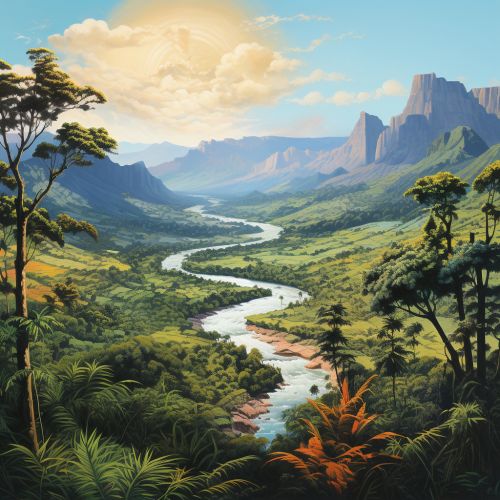Geography of Brazil
Geography of Brazil
Brazil, officially known as the Federative Republic of Brazil, is the fifth largest country in the world, both in terms of area and population. It is located in the eastern part of South America, stretching from the Atlantic Ocean to the Andes Mountains. The geography of Brazil is characterized by its vast size, diverse landscapes, and varied climates.
Physical Geography


Brazil's land area is approximately 8.5 million square kilometers, making it the largest country in South America and the fifth largest in the world. The country's vast size means that it spans four time zones and encompasses a diverse range of landscapes and ecosystems.
Brazil's terrain can be broadly divided into five main physical regions: the Amazon Basin, the Pantanal, the Central Plateau, the Atlantic Forest, and the Pampas. Each of these regions has its own unique geographical features and ecosystems.
Amazon Basin
The Amazon Basin is the largest river basin in the world, covering an area of approximately 7 million square kilometers. It is home to the Amazon Rainforest, the largest tropical rainforest in the world, which is renowned for its biodiversity. The Amazon River, the second longest river in the world, flows through the basin and has a significant impact on the region's geography and ecology.
Pantanal
The Pantanal is the world's largest tropical wetland, covering an area of approximately 150,000 square kilometers. It is located in the western part of Brazil, extending into Bolivia and Paraguay. The Pantanal is known for its rich biodiversity, including a large number of bird species.
Central Plateau
The Central Plateau, also known as the Brazilian Highlands, is a vast plateau that covers a large part of central and eastern Brazil. It is characterized by its rolling hills, wide valleys, and vast grasslands. The Central Plateau is also home to Brazil's capital, Brasília.
Atlantic Forest
The Atlantic Forest is a diverse and rich ecosystem that stretches along Brazil's Atlantic coastline. Despite its significant reduction due to urban growth and agriculture, it remains one of the world's key biodiversity hotspots.
Pampas
The Pampas are a fertile lowland region located in the southern part of Brazil, extending into Uruguay and Argentina. This region is known for its rich agricultural lands and is a major producer of beef and wheat.
Climate
Brazil's climate varies greatly due to its large size and geographical diversity. The country can be divided into five main climatic regions: equatorial, tropical, semi-arid, highland tropical, and subtropical.
Equatorial Climate
The equatorial climate is found in the Amazon Basin, where it is hot and humid year-round. Rainfall is abundant, with no dry season.
Tropical Climate
The tropical climate is found in the central and eastern parts of Brazil. This region experiences a wet season and a dry season, with high temperatures throughout the year.
Semi-Arid Climate
The semi-arid climate is found in the northeastern part of Brazil, known as the Sertão. This region is characterized by high temperatures and low rainfall.
Highland Tropical Climate
The highland tropical climate is found in the Central Plateau. This region experiences a mild climate with a wet season and a dry season.
Subtropical Climate
The subtropical climate is found in the southern part of Brazil. This region experiences four distinct seasons, with cold winters and hot summers.
Human Geography
Brazil's human geography is as diverse as its physical geography. The country's population is a mix of indigenous peoples, descendants of African slaves, and immigrants from Europe, the Middle East, and Asia. This diversity is reflected in the country's culture, language, and social structure.
Brazil's population is heavily concentrated along the Atlantic coast, particularly in the southeastern states of São Paulo and Rio de Janeiro. The country's interior, particularly the Amazon Basin, is sparsely populated.
Brazil's urbanization rate is high, with the majority of the population living in cities. The country's largest cities are São Paulo, Rio de Janeiro, and Salvador.
Environmental Issues
Brazil faces a number of environmental issues, including deforestation, biodiversity loss, water pollution, and climate change. The country's vast size and diverse ecosystems make it a key player in global environmental issues.
Deforestation
Deforestation is a major issue in Brazil, particularly in the Amazon Rainforest. The main drivers of deforestation are agriculture, logging, and mining.
Biodiversity Loss
Biodiversity loss is another major issue in Brazil. The country's diverse ecosystems are home to a large number of species, many of which are threatened or endangered.
Water Pollution
Water pollution is a significant issue in Brazil, particularly in urban areas. The main sources of water pollution are industrial waste, agricultural runoff, and untreated sewage.
Climate Change
Brazil is vulnerable to the impacts of climate change, including increased temperatures, changes in rainfall patterns, and sea level rise. The country's diverse ecosystems and large agricultural sector make it particularly susceptible to these impacts.
